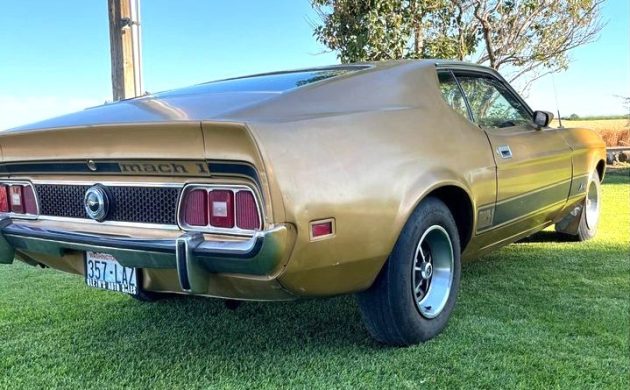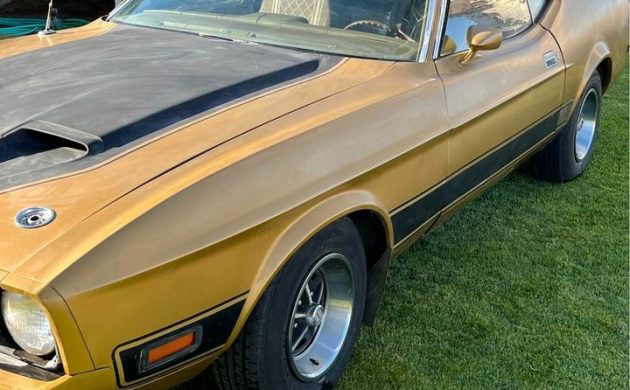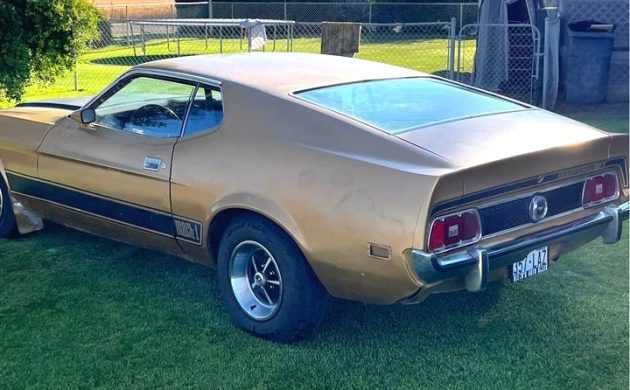After years of getting bigger and selling fewer cars each year, the 1973 model year would be the last for the first-generation Ford Mustang. The car would attempt to return somewhat to its roots in 1974 with the Mustang II, shifting from a Falcon platform to one employed by the subcompact Pinto. This seller says this ’73 fastback (or SportsRoof as Ford liked to call it) is a barn find with a V8 engine, but not much else is known about what appears to be a survivor.
Ford sold 135,000 Mustangs in 1973, a far cry from the peak in 1966 (607,000 units). But competition had eaten into market share and its weight gain of 800 lbs. over the years probably didn’t help. It’s hard to believe that a 1973 Mustang is the same car under the skin as a 1965. 35,000 Mach 1 fastbacks were produced in 1973, including this car per the lettering in the striping. Interesting that the seller doesn’t mention this being a Mach 1.
We’re not told the displacement of the V8 in this Mustang nor does the seller pop the hood for any photos. A 302 or 351 cubic inch engine is likely, if original, and the hood bulge implies something beefy. The seller says it has an automatic transmission and the mileage is 100,000, but that sounds like a placeholder. It’s said to be a complete, stock Mustang, but the seller doesn’t tell us if it runs or not. So, this could be a project or a turn-key opportunity, we just don’t know.
If you like these SportsRoof Mustangs that are hard to see out of the back, this one is available here on Facebook Marketplace. Located in Quincy, Massachusetts, this Ford comes with an asking price of $10,000.






Better then a sissy M2. Ford should have made them bigger and made the 428 the standard engine.
Then you would have another Torino.
Remember, (until recent generations) Mustangs at their core were simple, basic economy cars. Bread and butter though they may have been, that’s what paid the bills. The much-revered muscle cars were the exception.
in 1973 big blocks were not a big seller as insurance premiums were higher for them , and any that were still around would be an extremely hard sell after the Oil embargo. Ford knew what they were doing ; the big Mustangs were not big sellers, but the Mustang II , like the first Mustangs was a huge seller – it was the right car for the right time .
Oddly, 400 & 455 pontiac v8s sold well – more & more sales of t/a’s as the ’70s progressed.
JoeNYWF64 as DON put it the Mustang II was the right car at the time. In 1974 Ford sold 385,993, compared to Pontiac Firebird sales of 73,729. Which only 14,519 were Formula 400s, and 14,519 were a Trans Am. In 75 there were 188,575 Mustangs compared to 84,063 Firebirds, with 13,670 being a Formula 400 and 27,274 being a Trans Am. In 76 there were 187,567 Mustangs compared to 110,775 Firebirds, with 20,613 being a Formula 400 and 46,704 being a Trans Am. In 77 there were 153,173 Mustangs compared to 155,735 with 21,801 being a Formula 400 and 68,744. In 78 there were 192,410 compared to 187,294 Firebirds with 24,346 with being a Formula 400 and 93,351 being a Trans Am. So if the goal was to sale cars, the Mustang II won out.
The total ’70s firebird PROFIT for Pontiac may be closer than one might think – to Ford’s & its Mustang II.
What really made money for the car companies were OPTIONS. As the ’70s progressed, more & more firebirds were ordered with LOT of options, including a/c, p/w, etc. I don’t think p/w were even available on mustang IIs! & only on ’71-73s prior to the IIs.
I would think not that many IIs were ordered with a/c either.
So i think a car company would prefer to sell less bigger cars with more options than more cars(especially economy cars) with few options.
It’s located in Quincy Washington, there is a good chance rust won’t be a major issue. The asking price seems seems pretty reasonable, it’s surprising the listing is a week old.
Steve R
What about if it’s Quincy, Massachusetts?
Then its a huge issue !!! lol
Rust maybe not but both quarter panels look strangely lumpy and the paint on the left one looks patchy like it’s hiding something. Just saying.
“It’s hard to believe that a 1973 Mustang is the same car under the skin as a 1965.” A 73 Mustang is not the same car under the skin as a 65 Mustang.
In my opinion, 71-73 Mustangs are 3rd gen. I think because of Ford calling the 74-78 Mustangs, Mustang II, is why people group 65-73 as first gens.
For the umpteenth time, the Mustang II does not utilize a platform “employed by the subcompact Pinto.”
Classification of car generations is subject to multitudes of factors, including judgement, but Mustang enthusiasts classify everything through 1973 as First Generation.
There’s an article on a Mustang II in the current issue
of Hemmings Classic Car magazine that explains that.NO,
it is not a Pinto underneath.
And the first Mustangs were not reskinned falcons. Different wheel base, steering ratio, gas tank, suspension, transmission gearing etc.
They did use the same platform ,though. Not sure about steering box ratios and transmission gears especially on the six cyl cars , but the gas tank from a wrecked 66 Mustang fit right into the space in the trunk for my 67 Futura way back in 1979
I know you could get all prior gen mustang fastbacks with a strait 6 cyl, but could you get a ’71-73 fastback with a 6 cyl?
I’m surprised those modern seat covers fit that well.
Yes, a 6 was available in 71-73 Mustangs
Ahhh the 351 mustang sports root! What a fine steed this made back in 1980!
Those aren’t Massachusetts license plates.
Washington plates.Looks like the pictures were taken in
Eastern Washington.